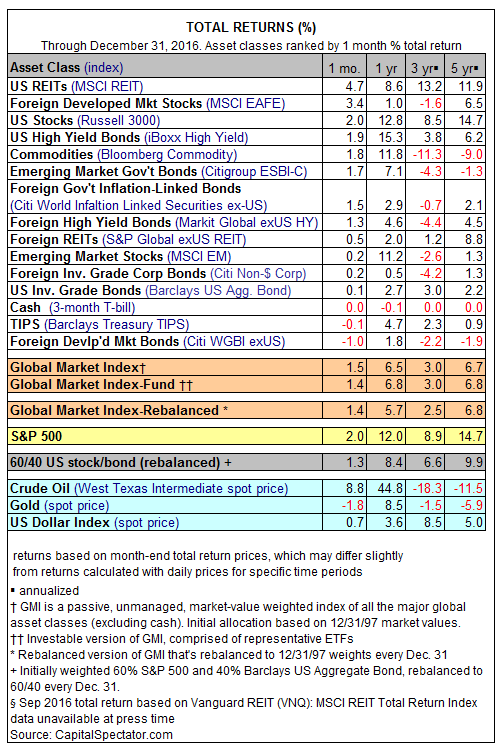Dear friends,
Well, the Patriots have the NFL’s best record (
14-2) and have outscored their opponents by a league-high
19
1 points this year, which is a pretty good signal that New Year’s is upon us and the January issue of the Mutual Fund Observer has launched. You can find it at
http://www.mutualfundobserver.com/issue/january-2017/.
Highlights of our January issue include:
Snowball’s “publisher’s letter” shares a hard truth: despite everything you’ve heard in the past year, things are getting better. Distinctly better. Historically better. Globally better. He shares the evidence, offers you a chance to make a difference in the life of a child and presents “the 2% challenge.”
Leigh Walzer, president of Trapezoid LLC, looks at the role of investor activism in prying open the value locked away in closed-end fund portfolios; at base, the liquidation value of the funds routinely exceeds their market NAVs which leads more and more activists to look for quick gains through forced liquidations.
Ed Studzinski returns to the question of fund expenses. We celebrate expense reductions. Ed asks us to consider the cost of those reductions; when a fund dependent on talent fires its talent, who gains?
Bob Cochran reminds us that prediction is easy while getting it right is hard. Maybe impossible. That has distinct consequences for how you need to approach your finances. Bob lays out the case for humility for us.
Charles Boccadoro updates folks on developments at MFO Premium; the chief one is a reader-inspired change that eliminates the effect of loads on return calculations. That’s based on the observation that virtually all loaded funds are now available with waivers. See Charles for details.
Snowball also spends a moment trying to reason with the fund community, using the lens of an abandoned, sand-filled squatter toilet in the weeds behind a rural farmhouse as a way of focusing their attention. The question at the bottom line: are you stubborn enough to choose failure on your own terms to success that requires change? Cue Sinatra: “I did it myyyyyy …”
Dennis Barran completes an Intrepid trifecta with his extended profile of Intrepid International (ICMIX), a young fund that mirrors Intrepid’s absolute value, risk-aware, small cap value orientation.
One of the decade’s best emerging markets managers has re-emerged. Rajiv Jain, long-time star manager of Virtus Emerging Markets Opportunities (HEMZX), resigned from Vontobel Asset Management in March to start his own firm. On December 28, GQG Partners Emerging Markets Equity launched with Mr. Jain at the helm. It’s much like his previous charge, give or take the fact that he’s unambiguously in charge and is managing $30 million rather than $48 billion. We share a little detail in our first Launch Alert.
Our second Launch Alert focuses on Cognios Large Cap Value, which represents the strategy being the “long” portfolio at the five-star Cognios Large Cap Market Neutral Fund.
Last month we highlighted the launch of Rondure Global Advisors, a partnership between former star Wasatch manager Laura Geritz and her former Wasatch colleagues who launched Grandeur Peak. This month we provide first word about her two funds in registration which will be available to you in March.
But wait, there’s more! We detail a relatively modest
19 fund liquidations and Chip tracked down three dozen manager changes, one of which strikes us as quite odd. We found
16 funds in registration, including a suite from BNP Paribas and a couple other goodies. There’s other stuff, too.
If you prefer the long scrolling format, find it at
http://www.mutualfundobserver.com/2017/1/We hope you enjoy it all in the January Mutual Fund Observer at www.mutualfundobserver.com!

